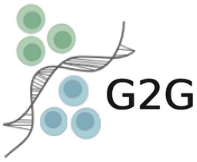G2G aims to guide downstream comparative analysis of single-cell reference and query systems along any axis of progression (e.g. pseudotime). This is done by employing a new dynamic programming (DP) based alignment algorithm which unifies both matches and mismatches. Our DP algorithm incorporates a Bayesian information-theoretic scoring scheme with a five-state probabilistic machine to generate an optimal alignment between a reference trajectory and query trajectory of a given gene in terms of their scRNA expression.
We can use the G2G framework to perform comparisons across pseudotime such as:
- Organoid vs. Reference tissue
- Control vs. Treatment
- Healthy vs. Disease
"Gene-level alignment of single cell trajectories informs the progression of in vitro T cell differentiation"
Authors: Dinithi Sumanaweera†, Chenqu Suo†, Daniele Muraro, Emma Dann, Krzysztof Polanski, Alexander S. Steemers, Jong-Eun Park, Bianca Dumitrascu, Sarah A. Teichmann*
Available at: https://www.biorxiv.org/content/10.1101/2023.03.08.531713v1
For now, G2G needs to be installed from GitHub:
pip install git+https://github.com/Teichlab/Genes2Genes.gitThe package will be made available on PyPi soon.
(1) Reference anndata object (with adata_ref.X storing log1p normalised gene expression),
(2) Query anndata object (with adata_query.X storing log1p normalised gene expression), and
(3) Pseudotime estimates stored in each anndata object under adata_ref.obs['time'] and adata_query.obs['time'].
Please refer to the notebook notebooks/G2G_Tutorial.ipynb which gives an example analysis between a reference and query dataset from literature.
